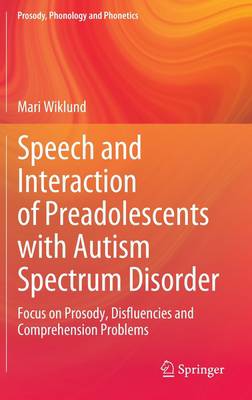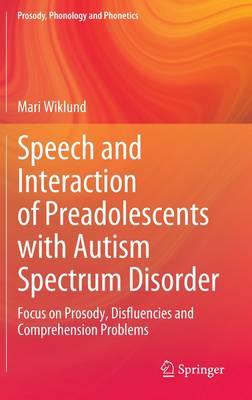
- Retrait gratuit dans votre magasin Club
- 7.000.000 titres dans notre catalogue
- Payer en toute sécurité
- Toujours un magasin près de chez vous
- Retrait gratuit dans votre magasin Club
- 7.000.0000 titres dans notre catalogue
- Payer en toute sécurité
- Toujours un magasin près de chez vous
Speech and Interaction of Preadolescents with Autism Spectrum Disorder
Focus on Prosody, Disfluencies and Comprehension Problems
Mari Wiklund
183,45 €
+ 366 points
Description
Preface1. Introduction1.1. Background1.2. Topics treated in the book1.3. Data1.4. Methods2. Prosody2.1. Overview of previous research on the prosody of persons with ASD2.2. Prosodic characteristics of preadolescent boys with ASD2.3. Perception of atypicality by neurotypical listeners2.4. The role of prosodic features in the creation of comprehension problems2.5. Conclusion3. Disfluencies3.1. Overview of previous research on disfluencies in the speech of persons with ASD3.2. Disfluencies in the speech of preadolescent boys with and without ASD3.3. The role of disfluencies in the creation of comprehension problems3.4. Conclusion4. Comprehension problems4.1. Overview of previous research on conversational repairs in the interaction of persons with ASD4.2. Causes of comprehension problems in group therapy sessions involving preadolescent boys with ASD4.2.1. Overly literal interpretation of speech4.2.2. Topical discontinuities4.2.3. Non-verbal features associated with trouble-source turns: the role of eye contact4.2.4. Other causes of comprehension problems4.3. Conclusion5. Gaze behavior5.1. Overview of previous studies on the role of gaze in interaction from a conversation analytic point of view 5.2. Overview of previous studies on gaze-related features in the interaction of persons with ASD.5.3. Three main patterns used for avoiding eye contact in group therapy sessions involving preadolescents boys with ASD5.3.1. Fixing one's gaze straight ahead5.3.2. Letting one's gaze wander around5.3.3. Looking at one's own hands when speaking5.4. General remarks on the gaze behaviour of preadolescents boys with ASD5.5. Conclusion
6. Therapists' response strategies and teaching orientations 6.1. Therapists' response strategies in group therapy sessions involving preadolescent boys with ASD6.1.1. Introduction6.1.2. Five most common response strategies6.1.2.1. Approval 6.1.2.2. Comment on the contents of a turn / turns 6.1.2.3. Question addressed to the whole group 6.1.2.4. Question concerning the contents of a turn / turns 6.1.2.5. Rephrasing the contents of a turn / turns 6.2. Therapists' teaching orientations in group therapy sessions involving preadolescent boys with ASD6.2.1. Introduction6.2.2. Implicit teaching orientation6.2.3. Explicit teaching orientation6.2.4. Prosodic problems: beyond teaching orientations?6.3. Conclusion7. ConclusionBibliography List of transcription conventionsIndex of key words
6. Therapists' response strategies and teaching orientations 6.1. Therapists' response strategies in group therapy sessions involving preadolescent boys with ASD6.1.1. Introduction6.1.2. Five most common response strategies6.1.2.1. Approval 6.1.2.2. Comment on the contents of a turn / turns 6.1.2.3. Question addressed to the whole group 6.1.2.4. Question concerning the contents of a turn / turns 6.1.2.5. Rephrasing the contents of a turn / turns 6.2. Therapists' teaching orientations in group therapy sessions involving preadolescent boys with ASD6.2.1. Introduction6.2.2. Implicit teaching orientation6.2.3. Explicit teaching orientation6.2.4. Prosodic problems: beyond teaching orientations?6.3. Conclusion7. ConclusionBibliography List of transcription conventionsIndex of key words
Spécifications
Parties prenantes
- Auteur(s) :
- Editeur:
Contenu
- Nombre de pages :
- 158
- Langue:
- Anglais
- Collection :
Caractéristiques
- EAN:
- 9789811981166
- Date de parution :
- 10-01-23
- Format:
- Livre relié
- Format numérique:
- Genaaid
- Dimensions :
- 156 mm x 234 mm
- Poids :
- 412 g

Les avis
Nous publions uniquement les avis qui respectent les conditions requises. Consultez nos conditions pour les avis.






